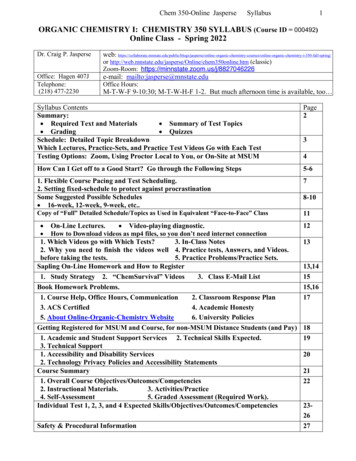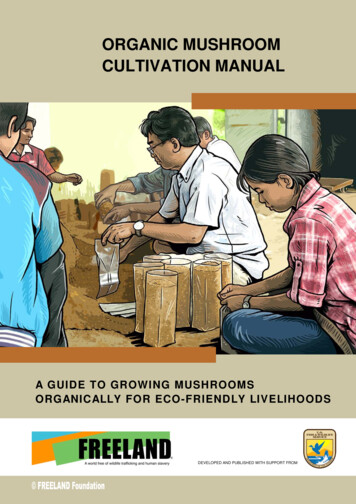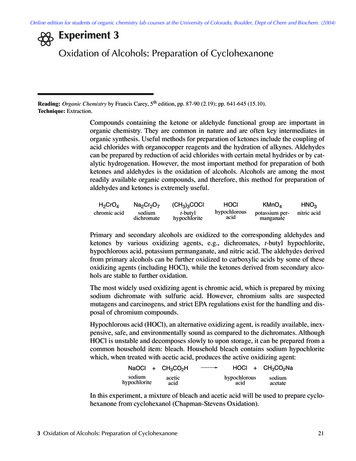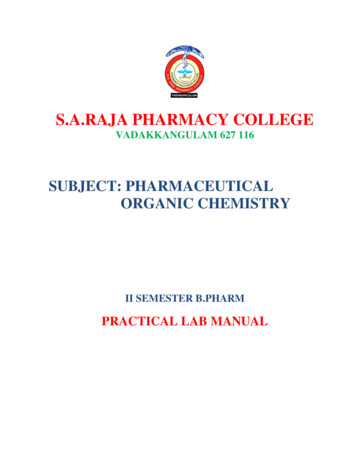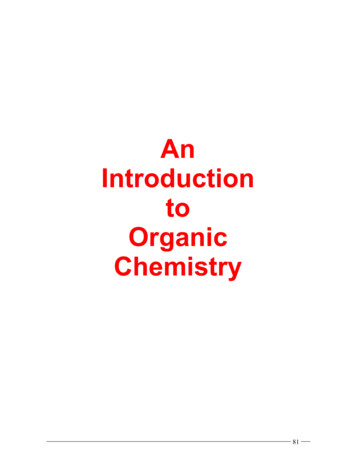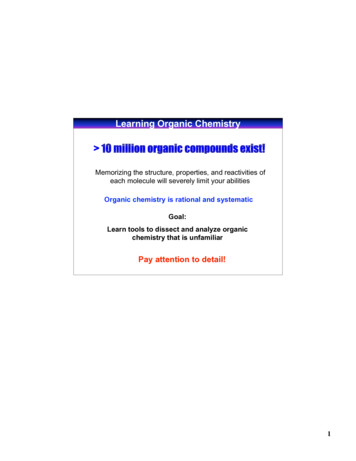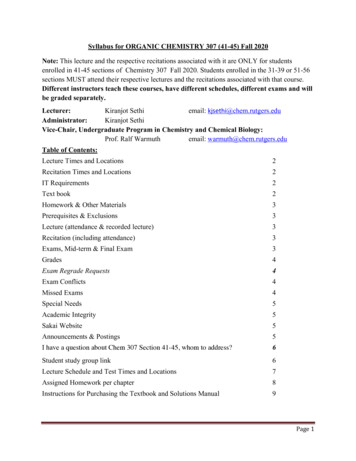
Transcription
1 Pagehttps://www.cienotes.com/Organic Chemistry (AS)Alkane (saturated hydrocarbon): Combustion (complete and incomplete)Free-radical substitutionCracking (elimination): alkane alkene alkane (no oxygen, high temperature, zeolitecatalyst)Alkene (unsaturated hydrocarbon): Addition (electrophilic addition): Hydrogen (H2 (g)): CH2 CH2 H2 CH3CH3 (140 , Ni catalyst) Steam (H2O (g)): CH2 CH2 H2O CH3CH2OH (330 , 6MPa, H3PO4) Hydrogen Halides (HX (aq)): CH2 CH2 HBr CH3CH2Br (conc. HX, r.t.p.) Halogens (X2 (aq)): CH2CH2 Br2 CH2BrCH2Br (r.t.p. Test for the presence of C C bond (decolourisation of Br2)Page 1
2 Page https://www.cienotes.com/Oxidation: Cold Dilute Acidified Manganate(VII) Solution (KMnO4) Hot Concentrated Acidified Manganate(VII) Solution (KMnO4) Addition PolymerisationPage 2
3 PageHalogenoalkane: https://www.cienotes.com/Subsitution (nucleophilic substitution): Aqueous Alkali (OH- (aq)): CH3CH2Br NaOH CH3CH2OH NaBr / CH3CH2Br H2O CH3CH2OH HBr (Heated under reflux) Alcohol produced KCN (CN- (in ethanol)): CH3CH2Br CN- CH3CH2CN Br- (heated under reflux) Addition of carbon atom Nitrile produced Ammonia (NH3 (in ethanol)): CH3CH2Br NH3 CH3CH2NH2 HBr (heated) Alkylamine producedMechanism: Primary Halogenoalkane (SN2): S stands for substitution, N stands for nucleophilic, 2is the rate of reaction; depends on both conc. of halogenoalkane and hydroxideions present. Tertiary halogenoalkanes (SN1): two-step mechanism, where a carbocation isproduced, due to the stability of the carbocation – due to the inductive effect of thealkyl groups attached to the C atom; depends on only the conc. of thehalogenoalkane (slow-step)Page 3
4 Page https://www.cienotes.com/ Secondary halogenoalkane (SN1 and SN2)Elimination: CH3CHBrCH3 NaOH(ethanol) CH2 CHCH3 H2O NaBr Ethanolic sodium hydroxide as the reagent HBr eliminated from the 2-bromopropane Propene producedAlcohol: Hydrogen bonding causes the higher boiling point than expected compared to otherorganic molecules with similar relative molecular masses.Combustion: C2H5OH 3O2 2CO2 3H2OSubstitution (forming halogenoalkane (nucleophilic substitution)): CH3CH2OH HCL CH3CH2Cl H2O Chloroalkane produced Occur due to the partial positive charge of the C atom bonded to thehydroxyl group Carbon atom open to nucleophilic attack (by the partially negative halogenatom in the hydrogen halide) Dry HCl(g) made in situ: NaCl H2SO4 NaHSO4 HCl C2H5OH SOCl2 C2H5Cl HCl(g) SO2(g) Sulfur dichloride oxide as the reagent C2H5OH PCl5 C2H5Cl HCl(g) POCl3 At room temp. Phosphorus halides as the reagent Test for hydroxyl group: steamy fumes of HCl observed 3C2H5OH PCl3 3C2H5Cl H3PO3 Requires heating Phosphorus (III) chloride as the reagent 3C2H5OH Pl3 3C2H5l H3PO3 Requires heating with the alcohol Phosphorus (III) halide made in situ using red phosphorus and bromine oriodineSubstitution with sodium metal: C2H5OH Na C2H5O-Na H2(g) O-H bond in the alcohol breaks instead of C-O Sodium alkoxide produced - basic ionic compound (sodium ethoxide in the ex.) H2 gas given offEsterification: CH3CH2COOH CH3CH2OH CH3CH2COOC2H5 H2O Ethyl propanoate produced Reagents heated under reflux with a strong acid catalyst (conc. H2SO4) Esters produced usually have sweet, fruity smell Esters used in artificial flavouring, perfumes and solventsPage 4
5 Page https://www.cienotes.com/Hydrolysis of Esters: With an acid (H2SO4) – catalyst: Reverses the preparation of an ester from analcohol and a carboxylic acid. Reaction will be reversible and an equilibrium mixture is established. With an alkali (NaOH(aq)): fully hydrolysed An alcohol and the sodium salt of the carboxylic acid produced Dehydration (Elimination): CH3CH2OH CH2 CH2 H2O Heating required Catalyst: Al2O3 (s) - powder or H2SO4 Alkene produced Oxidation (using potassium dichromate(VI) solution, K2Cr2O7, acidified with dilute H2SO4– Orange Cr2O72-(aq) reduced to green Cr3 (aq), warming of reaction mixture required): Tertiary alcohol: No change, remains orange Secondary alcohol: Oxidised to form a ketone, turns green Primary alcohol: Oxidised to an aldehyde (distillation), where further oxidationforms carboxylic acid – achieved by reflux with excess acidified potassiumdichromate(VI):Page 5
6 Pagehttps://www.cienotes.com/ Nitrile: Hydrolysis: CH3CH2CN HCl 2H2O CH3CH2COOH NH4Cl Alkanenitrile to carboxylic acid Refluxed with dilute HClReduced to an amine (NH2): –CN 4[H] –CH2NH2 Na & ethanolCarboxylic Acid: Dissociation: CH3COOH(aq) CH3COO-(aq) H (aq) alkanoate ions producedNeutralisation (Alkali): CH3COOH NaOH CH3COONa H2OReactive metals: 2CH3COOH Mg (CH3COO)2Mg H2 Salt (magnesium ethanoate) and H2(g) producedCarbonates: 2CH3COOH K2CO3 2CH3COOK H2O CO2 Salt (potassium ethanoate), H2O and CO2 producedReduction: CH3COOH 4[H] CH3CH2OH H2O Reducing agent: LiAlH4 (lithium tetrahydridoaluminate) – dry ether at r.t.p (v.Reactive) Primary alcohol producedAldehyde & Ketone: Reduction (reducing agents: NaBH4 (sodium tetrahydridoborate) Or LiAlH4 (lithiumtetrahydridoaluminate)): Aldehyde reducing agent primary alcohol CH3CHO 2[H] CH3CH2OH Ethanal into ethanol Ketone reducing agent Secondary alcohol CH3COCH3 2[H] CH3CH(OH)CH3 Propanone into propan-2-ol(Warming the aldehyde or ketone with an aqueous alkaline solution of sodiumtetrahydridoborate)Page 6
7 Page https://www.cienotes.com/(Adding lithium tetrahydridoaluminate dissolved in a dry ether, such as diethyl ether, atr.t.p. As it reacts vigorously with water and a more powerful reducing agent compared tosodium tetrahydridoborate)Nucleophilic addition with HCN (The HCN is generated in situ (in the reaction vessel) bythe reaction of sodium cyanide, NaCN, and dilute sulfuric acid): Increases the length of the hydrocarbon chainMechanism of Nucleophilic addition:Testing for the carbonyl group: Tri-iodomethane (Alkaline iodine solution test): Formation of yellow ppt. with methylketones, compounds containing CH3CO- group or secondary alcohol (CH3CH(OH)-) due toits oxidation into ketone (reagent: alkaline solution of iodine; warmed together with thesubstance being tested):Page 7
8 Page https://www.cienotes.com/Tollen’s reagent: Colourless to silver ‘mirror’ formation for aldehydeFehling’s solution: Clear blue turns to opaque red/orange as ppt. of copper(I) oxide formsthroughout the solution for aldehyde2,4-DNPH (2,4-dinitrophenylhydrazine) – condensation reaction: A deep-orange ppt. isformed when ketone or aldehyde is presentC C Electrophilic additionC O Nucleophilic additionOrganic Chemistry (A-level)Benzene: Organic hydrocarbons containing one or more benzene rings are called arenes. In general,compounds of benzene are known as aryl compounds or aromatic compounds; an exampleis chlorobenzene, which is one of the halogenoarenes. The simplest arene is benzene itself(C6H6)Benzene molecule is a planar, perfectly symmetrical moleculeEach carbon atom in the hexagonal ring is sp2 hybridised sharing: one pair of electrons with one of its neighbouring carbon atoms one pair of electrons with its other neighbouring carbon atom one pair of electrons with a hydrogen atomAll three are σ (sigma) bonds; leaves one electron to spare contributing to a π (pi) bond –delocalisedThe π bonding is formed by the overlap of carbon p atomic orbitals, where the lobes form aring of delocalised electrons above and below the plane of the carbon atoms.Page 8
9 Pagehttps://www.cienotes.com/Page 9
10 P a g e https://www.cienotes.com/Substitution (Cl & Br) – Electrophilic substitution: The Br2 molecule forms a dative (co-ordinate) bond with Iron (III) bromide bydonating a lone pair of electrons from one bromine atom into an empty 3d orbitalin the iron. This draws electrons from the other bromine atom in the Br2 moleculemaking it partially positive, creating the electrophile (Br ): The Br cation and the ‘electron-rich’ benzene ring are attracted to each other, asthe mechanism (electrophilic substitution) shows: Mechanism done at r.t.p & FeCl3, AlCl3 and FeBr3 (halogen carriers) catalyst Another example: When we halogenate alkylarenes, the halogen atom substitutes into thebenzene ring at positions 2 or 4. While in excess chlorine gas, we can form 1methyl-2,4,6-trichlorobenzene (2 and 6 positions in substituted arenes areequivalent)The C-X bond in halogenoarenes is stronger than the C-X bond in ahalogenoalkane, as one of the lone pairs on the halogen atom overlapsslightly with the π bonding system in the benzene ring, hence giving the C-Xbond a partial double bond characterFree-radical substitution (Cl & Br) into the alkylbenzene side-chain: In excess chlorine, eventually all three of the hydrogen atoms will be replaced bychlorine atomsPage 10
11 P a g e https://www.cienotes.com/Nitration – Electrophilic substitution: Conc. HNO3 & conc. H2SO4 to create the electrophile – nitronium ion (NO2 ion): Reflux with benzene at 55 to make nitrobenzene: Mechanism (In stage 1, NO2 is attracted to the high electron density of the πbonding system inn benzene; a pair of electrons donated to NO2 , forming a newcovalent bond, disrupting benzene’s ring of electrons (4 π bonding electrons and apositive charge spread over 5 carbon atoms. In stage 2, C-H bond breaksheterolytically, H ion leaves the system, restoring the full delocalised ring.): Further nitration yields 1,3,5-trinitrobenzene Alkylation or Acylation (Friedel-Crafts reaction): Friedel-Crafts reactions result in the introduction of a side-chain into a benzenering, also called alkylation or acylation reactionsPage 11
12 P a g ehttps://www.cienotes.com/ Mechanism: Oxidation of the side-chain: Alkylarenes’ alkane side-chain can be oxidised form carboxylic acid. Reagent and conditions: Reflux, alkaline potassium manganate(VII) then acidified with dilute H2SO4 Reflux, potassium dichromate(VI) then acidified with dilute H2SO4Phenol: Phenol, C6H5OH, a crystalline solid that melts at 43 , due to its hydrogen bonding,however, its non-polar benzene ring causes only a slight solubility in waterWeakly acidic (however still stronger than water or alcohol):Page 12
13 P a g ehttps://www.cienotes.com/ Phenol’s conjugate base (the phenoxide ion, C6H5O-(aq)), has its negative chargespread over the whole ion as one of the oxygen’s lone pairs overlaps with thedelocalised π bonding system, hence reducing the charge density of the C6H5O -(aq)compared with OH-(aq) or C2H5O-(aq); therefore H (aq) ions are less attracted tothe phenoxide than hydroxide or ethoxide ions, making phenoxide less likely to reform the undissociated molecules Phenol ionises to form a stable negative ion, so the position of equilibriumlies further to the right-hand side Ethanol is the weakest acid due to the electron-donating alkyl groupattached to the oxygen atom in the ethoxide ion, concentrating morenegative charge on the oxygen atom, which more readily accepts H ions(equilibrium lies further to the left-hand side) Breaking of OH bond: Slightly soluble in water, but dissolves well in alkaline solutions (NaOH): Sodium phenoxide salt is soluble in water Reacts vigorously with Na(s): H2 gas released (effervescence) & Sodium phenoxide salt produced Electrophilic Substitution into benzene ring: Phenol reacts with electrophiles more readily than benzene The overlap of one of the lone pairs of electrons on the oxygen atom in the OHgroup with the π bonding system increases the electron density of the benzene ringin phenol. This makes the benzene ring more open to attack from electron-deficientelectrophiles Substitution (Cl & Br) at r.t.p (a white ppt. forms):Page 13
14 P a g ehttps://www.cienotes.com/ Nitration with dilute nitric acid at r.t.p:ORCarboxylic Acids: Neutralisation (Alkali): CH3COOH NaOH CH3COONa H2O Carboxylate salt produced (Sodium ethanoate)Dissociation: CH3COOH(aq) CH3COO-(aq) H (aq) Alkanoate ions produced Considered as weak acids (equilibrium lies well over to the left-hand side),however are still stronger than alcohols The O-H bond in the carboxylic acid is weakened by the carbonyl group,C O: Carboxylate ion stabilised by the delocalisation of electrons around the –COO- group (spreading out the negative charge on the ion), reducing itscharge density, hence less likely to bond with an H (aq) ion to reform theundissociated acid molecule: Electron-withdrawing groups (halogens) bonded to the carbon atom next tothe –COOH group make the acid stronger: Electron-withdrawing groups further weaken the O H bond in theundissociated acid molecule Electron-withdrawing groups extend the delocalisation of thenegative charge on the COO– group of the carboxylate ion (pulling ofPage 14
15 P a g e https://www.cienotes.com/negative charge further from O-), making it less likely to bond with H (aq) ionsE.g. CCl3COOH which has three strongly electronegative Cl atoms allwithdrawing the electrons from the –COOH group, weakening the O-H bondmore than the other acids; once it is broken the resulting anion would bestabilised more effectively, making it less attractive to the H (aq) ionsE.g. CH3COOH is the weakest acid, due to its electron-donating nature: It strengthens the O-H bond in the acid’s –COOH group It donates negative charge towards the –COO- group of thecarboxylate ion, making it more prone to accept H Oxidation Of HCOOH (methanoic acid): Special cases of carboxylic acids which can undergo further oxidation Oxidation will occur with strong oxidising agents: Reflux with alkaline potassium manganate(VII) then acidified with diluteH2SO4 (decolourising the purple solution) Reflux with potassium dichromate(VI) then acidified with dilute H2SO4(solution turns from orange to green)Page 15
16 P a g ehttps://www.cienotes.com/ Oxidation will occur with milder oxidising agents: Fehling’s and Tollen’s – same positive results as test for adehydes Oxidation Of (COOH)2 (ethanedioic acid): Oxidised by only strong oxidising agents The reaction is often used to standardise potassium manganate(VII) solution: A standard solution of ethanedioic acid is acidified with dilute sulphuric acid,warmed and titrated with potassium manganate(VII) solution from theburette Decolourisation of potassium manganate(VII) solution can be observed untilthe end-point when a trace of pale pink remains An example of an autocatalysis reaction, where Mn2 (the product) acts as thecatalysis for that reaction Nucleophilic substitution, forming acyl chlorides: Replacement of carboxylic acid’s –OH with a Cl atom: Reagents and conditions: Phosphorus(V) chloride (r.t.p.): Phosphorus(III) chloride (heating required): Sulfur dichloride oxide (r.t.p.):Acyl Chlorides: Acyl chlorides are more reactive than carboxylic acid, hence are more used in compoundsynthesis:Page 16
17 P a g ehttps://www.cienotes.com/ The carbonyl carbon has electrons drawn away from it by electronegative atoms (O and Cl),giving it a large partial positive charge, open to nucleophiles: Reactions will cause C-Cl bond to break; HCl(g) to be given off as white fumes: Where HZ can be water, an alcohol, ammonia or an amine (contains either anoxygen or nitrogen atom with a lone pair that can be donated – nucleophile) Hydrolysis (r.t.p.): A lone pair on the oxygen atom in water initiates the attack on the δ carbonylcarbon atom Carboxylic acid and HCl(g) forms The ease of hydrolysis: acyl chloride chloroalkane aryl chloride Acyl chloride has a more δ carbon compared to chloroalkane, due to theattachment of an oxygen atom to the chlorine bonded carbon Aryl chloride will not undergo hydrolysis due to the overlapping of p orbitals of theCl atom to the delocalised p electrons in the benzene ringEsterification: When acyl chlorides reacts with alcohols or phenol, esters (and HCl) formed Reaction will occur more quickly and go to completion compared to that ofcarboxylic acid alcohols:Page 17
18 P a g ehttps://www.cienotes.com/ To produce phenyl esters ( phenol), acyl chlorides must be used, warmed and inthe presence of a base (NR with carboxylic acid); where in the initial reaction,phenoxide ion (C6H5O-) will form to act as the nucleophile to attack the acylchloride: Nucleophilic substitution with amines: Amines with a lone pair of electrons acts as a nucleophile and attacks the carbonylcarbon atom in acyl chlorides (reaction is vigorous and a substituted amideformed):Amines: Three classes of amine: primary (NH2 group bonded to an alkyl or aryl group, e.g.ethylamine (C2H5NH2) or phenylamine (C6H5NH2)), secondary (two alkyl or aryl groupsattached to an NH group, e.g. dimethylamine (CH3)2NH), tertiary (three alkyl or aryl groupsattached to the same nitrogen atom, e.g. trimethylamine (CH3)3N)Ammonia and amines act as bases due to the lone pair of electrons on the nitrogen atom(donation of the lone pair to a H ion, forming a co-ordinate (dative) bond)Reaction with dilute acids (HCl in the example):Page 18
19 P a g e https://www.cienotes.com/The strength of ammonia and amines as bases depends on the availability of the lone paurof electrons on their N atom to bond with an H ion Ethylamine ammonia due to the ethyl group’s electron-donating nature, releasingmore electrons towards the N atom Ammonia phenylamine due to the overlapping of the p orbitals on the nitrogenatom with the π bonding system in the benzene ring, causes the lone pair todelocalise into the benzene ring: benzene ring’s electron-withdrawing natureFormation of ethylamine: Ammonia (NH3 (in ethanol)) (excess) (hot) bromoethane, to avoid formation ofsecondary and tertiary amines Bromomethane KCN (potassium cyanide); reduced by adding of hydrogen to theethanenitrile (passing of the nitrile vapour and H2(g) over a nickel catalyst / LiAlH4in dry ether) Reduction of amides to amines, by using LiAlH4 in dry ether catalyst Formation of phenylamine: Reduction of nitrobenzene, by heating nitrobenzene with tin (Sn) and concentratedhydrochloric acid (separation of phenylamine from reacting mixture using steamdistillation:Page 19
20 P a g ehttps://www.cienotes.com/ Electrophilic substitution of Br(aq) into phenylamine: A white ppt. forms The nitrogen in the –NH2 group has a lone pair of electrons that can be delocalosedinto the benzene ring, increasing the electron density of the ring, hence more proneto electrophile attacks (reaction similar to that of phenols) Diazotisation: Used in the synthesis of dyes First step (must be kept below 10 due to the instability of the diazoniium salt –decomposes easily giving N2(g) at higher temperatures): Phenylamine nitrous acid (nitric(III) acid) diazonium saltThe positive charge on the diazonium ion (C6H5N2 ) is on the nitrogen atomshown with four bondsNitrous acid can be bade using sodium nitrite (sodium nitrate(III)) and diluteHCl: Second step: Diazonium ion reacts with an alkaline solution of phenol in a couplingreactionThe positively charged diazonium ion acts as an electrophile, substitutinginto phenol at the 4 positionAn orange dye – very stable – is formed, called an azo dye, or diazonium dyePage 20
21 P a g ehttps://www.cienotes.com/ The delocalised π bonding system extends between the two benzene ringsthrough the NN group Using alternative aryl compounds to phenol:Amino acids: The general structure: RCH(NH2)COOHExamples of amino acids: glycine (aminoethanoic acid) (R group: H atom) (simplest aminoacid); alanine (2-aminopropanoic acid) (R group: -CH3) The R group can be acidic (e.g. containing another –COOH group), basic (e.g. containinganother –NH2 group) or neutral (e.g. where R is an alkyl group)Interactions between the molecules within amino acids are possible due to its basic –NH2group and its acidic –COOH group (forming a zwitterions as it carries two charges): Zwitterion creates relatively strong intermolecular force due to their ionic nature (carryingtwo charges); they are crystalline solids that are soluble in waterSolutions of amino acids are amphoteric, buffer solutions:Page 21
22 P a g e https://www.cienotes.com/Two amino acids reacted together will create a dipeptide (condensation reaction –elimination of a small molecule when the reactant molecules join together): The amide link between the two amino acids are also called a peptide link The dipeptide product still has an –NH2 group and –COOH at its ends, hence thereaction can continue forming polypeptides and then proteinsAmides: Structural formula: CONH2, e.g. CH3CONH2 Amides are neutral compounds unlike amines, due to the presence of the electronwithdrawing oxygen atom in the amide group, hence the unavailability of lone pair on theamide’s nitrogen to donate to electron deficient species, such as H ionsFormation of amides: Ethanoyl chloride with conc. NH3(aq) producing ethanamide Primary amide with an acyl chloride producing a substituted amide Excess amines will react with HCl forming a salt (e.g. C2H5NH3 Cl-) Both reactions are in r.t.p.; white fumes of HCl forms The italic letter N is used in naming substituted amides to denote which alkyl (oraryl) group or groups are bonded to the nitrogen atom, e.g. N-ethylbutanamide,C3H7CONHC2H5, the ethyl (C2H5-) group has replaced an H atom in the amidegroup. If the H atom on the nitrogen in this molecule is replaced by another alkyl orPage 22
23 P a g e https://www.cienotes.com/aryl group, two N’s are used in the name, e.g. C3H7CON(C2H5)2 is called N,NdiethylbutanamideHydrolysis: Substituted amides (-CONH-): Reflux with, e.g. HCl(aq) or NaOH(aq):The product of hydrolysis with acid yields a carboxylic acid (R1COOH) and aprimary amine (R2NH2); excess acid in the reaction will react with amine toform ammonium salt, e.g. R2NH3 Cl- with excess HCl The product of hydrolysis with an alkali, the product are sodium salt of thecarboxylic acid (R1COO-Na ) and the primary amine (R2NH2) Unsubstituted amide (RCONH2): Same reactions and products, except ammonia will be produced instead ofprimary amines, and ammonium salts during excess of acid Page 23
Organic Chemistry (A-level) Benzene: Organic hydrocarbons containing one or more benzene rings are called arenes. In general, compounds of benzene are known as aryl compounds or aromatic compounds; an example is chlorobenzene, which is one of the halogenoarenes. The simplest arene is benzene itself (C6H6)File Size: 2MBPage Count: 23


